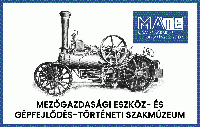SUMMARY
|
Using tractors in agriculture |
During some years the early engine structures was overcome by the four stroke compression engine of Nicolaus
August Otto patented in 1876.
Daimler and Benz founded the development of engine transport appliances bringing the high speed engine (800 revolution per minute instead of 160-180) into being.
The engine power machines together with locomotives used in agriculture took shape gradually. First as stable power machines, then as mobile drawing machines mounted on undercarriage – similar to the steam locomobiles – appeared in the last decades of 19th century. In the Carpathian Basin the explosion engine tractors spreaded in beginning of 20th century.
It was 1893 when the first petrol operating tractor got ready at Waterloo Gasoline Traction Engine Company in the state Iowa. Froelich petrol eingine power machine was the name of this 20 HP machine. To the start of 20th century petrol and petroleum operating selfpropelled power machined took shape, which were already real trators.
In 1906 the American Hart-Parr firm made a selfpropelled agricultural power machine which was labeled as tractor first. To the initial tractors only one forward gear were supplied so it was inestimable that on IHC tractors friction drives was used in 1906. As a result the tractor could move backward, too.
Beside wheel tractors the track type ones appeared which were constructed by Benjamin Holt. The characteristic of the Holt caterpillar tractor was the steering solved by means of a front wheel.
The American Ford firm presented its first primitive tractor of which a developed version became known in the whole world.
Between 1907 and 1913 a lot of solution was created where the power machine (engine) was directly mounted on the machine to be selfpropelled. A part of them remained only as experiment and a less part of them was ignored after some decade operation. Among the special selfpropelled machines the engine plough reached the greatest success. The Stock engine plough was the most known type of them in the Carpathian Basin. The Kőszegi engine tillage machine was presented in 1909 which is rather a technical interest.
The characteristics of tractors formed upto 1910 are the automatic suction valve, swing weight revolution control, tilting magnet ignition, a frame made of U-steel, cast iron gears, some gear simple drive, one speed forward and one speed backward, one standing cylinder engine and no cover.
In 1913 the Wallis factory constructed a tractor without a frame, which was substitued by the one piece drive and crankshaft box.
The first world war make it necessary that agricultural power machines be constructed which combuste other materials (wood-coal, wood, etc.) instead of the traditional fuel (gasoline, petroleum, diesel oil). The constructed suction gas engine meet these demands and were used in stable, mobile and selfpropelled form.
From 1914 hot-bulb, two stroke, naphta operating tractors appeared in the Hungarian agriculture, such as Svenson Avance, Munktells, and after a decade the Hungarian hot-bulb engine manufacture started.
In 1917 the Ford Motor Company engaged in large scale production of Fordson F tractors of which 750.000 piece was made within a decade for the agriculture of the world. Between 1920-1930 the Ford tractor was the determinant machine of the Hungarian tractor park.
In 1920 the IHC tractor factory put on the market the tractor which have a power shaft.
From the finding out of diesel engine (1897) the constructors dealt a lot with the application of the cheaper diesel fuel in tractor. A development took place in 1922 when the diesel engine without a compressor was discovered. This was used on a Benz – Sendling engine plough first in 1923. After it Benz tractor with no compressor diesel engine manufacture started in 1924.
An important station was the improvement of the drawing mechanizm in the development of tractors, when the three point suspension was solved on John Deere tractors.
A decade after the introduction of the mechanic three point suspension Harry Ferguson constructed the hydraulic system which became common only after the second world war.
At the end of the fourth decade of the 20th century all of the significant part were together on the tractors which are characteristics nowadays. So it has iron one piece shell, changeable parts which are subjected to extra wear, pressure lubrication, developed air filters, electric ignition and lightning, closed cooling system, rolling bearings, heat treated parts, power shaft, mechanic or hydraulic three point suspension, blown tyres, driver cabin and so on.
2011 © Minden jog fenntartva!
info@gepmuzeum.szie.hu



